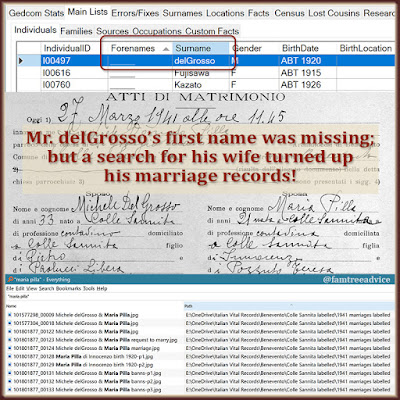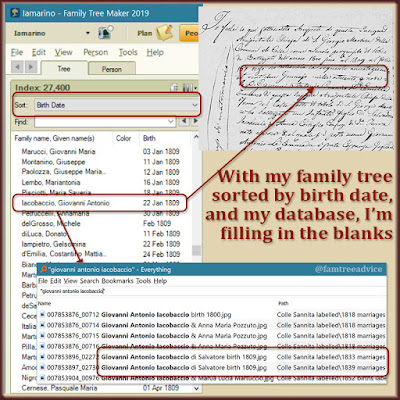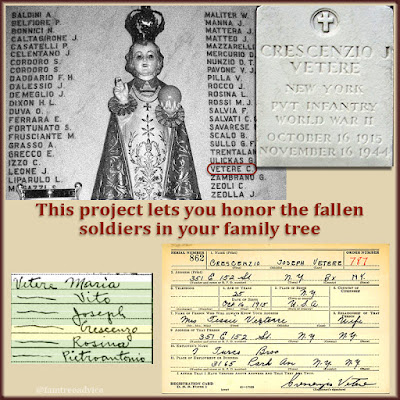Bringing a photo of my great grandmother Maria Rosa to life motivated me to do a ton of genealogy work.
I have all the available vital records from her Italian hometown on my computer. I worked hard to rename each file with the name of the subject. Looking at my Family Tree Maker file, I searched the records for all my great aunts and uncles on Maria Rosa's line. (I use a free program called Everything to locate any name in my collection of renamed vital records. It's the best tool you've never heard of.)
For each new great aunt and uncle who married, I added:
- their spouse's name, birth date, and parents.
- their marriage date and place.
- all the couple's children.
I sped up the process by adding all the facts to my family tree without the document images and their citations. I can go back and add those as needed, thanks to my process and the Everything program.
I added several hundred people from Maria Rosa's hometown to my tree in no time! I see this monumental task as the ultimate "Cousin Bait". I must be adding connections to other genealogy fans' and DNA matches' family trees.
Fixing a Hole
Working this fast can lead to gaps. I may go far up a bride's family tree and forget to go back to the groom. I thought I'd better do a spot check and look for the research holes I'd left behind.
Enter Family Tree Analyzer (FTA)—the best software for finding and fixing errors in your tree. And it's free.
Here's how to use FTA to find those information holes:
- Export a GEDCOM from Family Tree Maker (or wherever you build your family tree) and open it in FTA.
- Go to the Main Lists tab of FTA and see the first tab, Individuals. This shows all the facts in your tree.
- Click the BirthDate column to sort all your people by this date. Instead of blanks, you'll see the word UNKNOWN.
- Go to any person with the UNKNOWN birth date in your family tree. You should see that you are, in fact, missing their birth date.
 |
| If you still can't find their birth date, you must give each person an estimated birth year. |
Everyone in your family tree needs at least an estimated birth year. You're bound to have lots of people with the same name. An estimated birth year will prevent you from adding a 17th century father to a 19th century child.
I have a few rules for choosing an estimated birth year:
- If you know when their first spouse was born, mark them as being born about the same year. (Abbreviate "about" as Abt in your tree.)
- If this makes a woman much too old to have given birth to her children, adjust her estimated age down. You shouldn't make her more than 45 years old or so when she had her last child.
- If you know when their first child was born, estimate them to be 25 years older than the child.
- If you know when their parents were born, estimate them to be 25 years younger than their younger parent.
Finding More Holes
After fixing your unknown birth dates, go back to Family Tree Analyzer. Sort the Individuals list by DeathDate. Of course, lots of people in your family tree are still alive. You may have tons of UNKNOWN listings, many of which you are correct to leave blank.
I found it helpful to sort by the LifeSpan column. At the bottom of the list I have lots of people with a lifespan of 110 years or more. That means I haven't searched for and found their death records.
Thanks to the online Italian vital records, I can find a death record for most relatives born in the late 1700s. I'll choose a few from the list in FTA and search with Everything to fill in some holes.
But Wait! There's More
If you've been a careful genealogist and don't have a ton of missing dates, here's something else to try.
 |
| Sometimes a name is missing only because you haven't done the right search yet. |
Sort your FTA Individuals list by Forenames. How many first names are you missing? (Note: I record missing names as an underline: _____, so that's what I see in FTA.)
I have a 1st cousin twice removed named Maria Pilla who was born and married in Italy. She and her family came to America, and I found several U.S. records for them. But I never found her husband's first name. After a quick search for Maria Pilla, I realized I had their 1941 marriage record sitting on my computer. Now I know his first name and birth date, his parents' names, and that his mother was my 4th cousin 3 times removed.
Then, of course, there are the UNKNOWN Surnames. These may be all the women whose maiden names you haven't found. Let this list encourage you to give them another search.
Family Tree Analyzer is a great safety net.
If you're a busy genealogist, schedule a weekly checkup day with Family Tree Analyzer. It's available for PC and Mac at ftanalyzer.com. I'm inspired each time I launch it. You will be, too.









